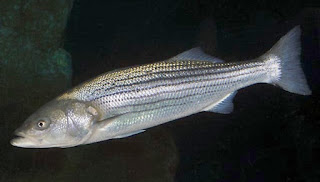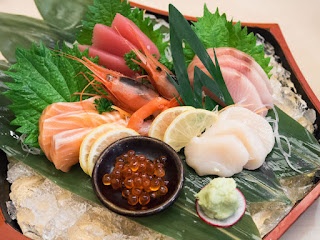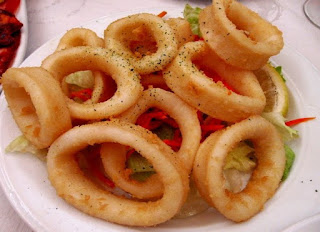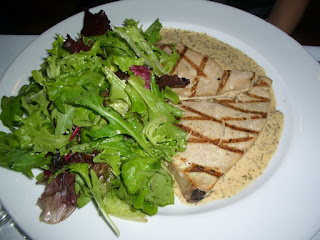 |
| Pairing seafood and wine |
Fish Attributes, Types and Flavors
Before we get into the details of wine and fish pairing it is important to understand the key attributes and flavor characteristic of fish, and why some fishes taste different from the others.The Key Attributes of Fish
There are a few attributes that make fish different from other kinds of meat and these attributes play an important role in understanding the chemistry of pairing wine with fish.Fish is different from other kinds of meat because their muscles are segmented to allow them to efficiently swim in the water. The muscles of fish are layered rather than bundled as in the other vertebrates and separated by connective tissues.
The composition of the muscles in a fish and therefore its texture and taste varies depending on its diet and its habitat. This gives some fish its flaky texture while others are more meaty.
 |
| Striped bass |
Freshwater fish generally do not accumulate amine oxides because their environment is less salty than the seawater and hence do not have the characteristic fishy smell/taste of ocean fish.
Different Types of Fish and Their Flavors
Fish can be grouped into white fish or oily fish based on how the oil is stored in them and these two groups have different texture and taste characteristics.Oily Fish
Oily fish store their fat in the form of oil throughout their bodies beside the belly cavity around the gut. Oily fish have a firm texture compared to white fish and a distinctive taste. They also have a comparatively darker flesh and a strong flavor.
 |
| Atlantic bluefin tuna |
Examples of oily fish: sardines, anchovies, mackerel, salmon, trout and tuna.
White Fish
White fish store their oil in the liver and much less overall when compared to oily fish. They are lean, with more delicate texture than oily fish. Generally the whiter the flesh, the more milder the taste. White fish can be flaky or firm and the flavor profile can vary from mild to medium depending on the type of fish.
 |
| Atlantic cod |
White fish having a medium flavor profile provide a good balance between the base flavor of the fish and the ingredients used in cooking.
Examples of white fish with mild flavor: sea bass, branzino, flounder, haddock, rainbow trout, red snapper, sole and tilapia.
Examples of white fish with medium flavor: striped bass, swordfish and grouper.
The Simple Science Behind Wine and Fish Pairing
Wine and fish pairing is not a complex procedure but rather an art of creating a good harmony between different flavors with a little help from understanding the simple science behind wine and fish pairing. |
| Different fish types and flavors |
Fish and wine each have their own characteristics and flavors—the art of pairing seeks to bring the best out of each, to create a dining experience that is a harmony of different flavors—by ensuring that the individual characteristics of fish and wine complement each other.
Fish as we know, has its own characteristics depending on its type, as the oily fish has a stronger flavor profile than the white fish, besides the difference in texture across the different types.
Additionally, the spices and sauces used in cooking the fish and the method of cooking play an important part in influencing the flavor, and the feel and taste of the fish in your mouth, varying from light to heavy.
The important characteristics of a wine that defines its structure are its tannins, acidity, alcohol level and sweetness. Each of these characteristics play an important role when pairing wine with fish and influences the overall quality of the dining experience.
Three Most Important Guidelines for Pairing Wine with Fish
- The acidity in a wine is an important characteristic as it cuts through the oil or fat and the fishy aroma/taste of the fish while keeping the palate engaged and fresh, ready for the next bite of the meal.
- Fish with a lighter flavor profile needs a light bodied wine while those with a stronger flavor profile can be paired with a medium bodied white wine or a red wine with soft tannins depending on the flavor strength of the fish.
- Tannins in the wine can easily overpower the delicate flavors of the fish but a wine with lighter tannins like a rosé or a red wine with soft tannins and good acidity can complement a fish with stronger flavors.
Pairing Wine with Fish
Wine and fish are a personal taste, besides the objective of any dining experience is to enjoy the wonderful flavors of the meal based on what pleases your palate. The same applies to the choice of wine—if you have a favorite wine, or a particular grape varietal or a wine style that pleases you the most, it is the best wine to pair with your dinner.However, wine and fish pairing experience is also driven by the chemistry of their individual characteristics and having a knowledge of these factors, could expand and elevate your dining experience, as it would enable you to substitute different types of fish and different types of wines from the ones you have already tried before.
 |
| Pairing wine and fish |
- Light bodied white wines with delicate mild flavored white fish
Light bodied white wines having refreshing acidity pair well with delicate white fish having a mild flavor such as branzino, halibut, Pacific cod, tilapia and sea bass.
Some light bodied white wines for fish pairing are Sauvignon Blanc (from cooler temperature regions), wines made from the Spanish Albariño or Portuguese Alvarinho grape varieties, Italian Pinot Grigio and Spanish Verdejo. - Sparkling wines and light bodied white wines with fried fish
Sparkling wine and light bodied white wines having refreshing acidity pair well with fried fish, as the acidity helps cut through the oil.
Sparkling wines like Champagne and Cava are a great pairing with fried fish.
- Medium bodied white wines with medium textured and medium flavored fish
Medium bodied white wines having good acidity pair well with fish that have a medium texture and a medium flavor profile like Chilean sea bass, swordfish and grouper.
Some medium bodied white wines for fish pairing are Chardonnay, dry Chenin Blanc, dry Riesling and Spanish white Rioja.
- Lighter reds and good acidity white wines with firm textured and strong flavored fish
Lighter reds having good acidity and white or sparkling wines with refreshing acidity pair well with fish that have a firm texture and a strong flavor profile like smoked trout, grilled salmon, grilled sardines and seared or grilled tuna.
The lighter reds with softer tannins having good acidity and flavor are a good accompaniment with these strong flavored fish while white and sparkling wines with refreshing acidity provide a great pairing experience as they match the rich fat content of the strong flavored fish.
Some lighter red wines for fish pairing are rosé, Pinot Noir (from cooler temperature regions), French Beaujolais and dry Lambrusco.
Five Delightful Wine and Fish Pairings
Beyond the natural pairings there are some wines that go very well with certain types of fish or seafood and create a delightful dining experience.For these pairing suggestions, the spices and ingredients used in the preparation and the method of cooking are also taken into consideration in the selection of the wine.
Champagne with Fried Calamari or Squid
 |
| Fried calamari |
Riesling or Moscato d'Asti with Spicy White Fish or Grilled Shrimp
 |
| Grilled shrimp taco |
Sparkling Rosé with Smoked Salmon
 |
| Smoked salmon |
Sauvignon Blanc with Herb Flavored Flounder, Haddock or Tilapia
 |
| Tilapia baked with fresh herbs |
Pinot Noir or Gamay with Bluefish or Tuna & Grenache with Grilled Sardines
 |
| Tuna steak |
Pinot Noir from Burgundy in France, Oregon in USA or from other cooler climate regions and wines made from the Gamay grapes grown in the Beaujolais region of France have soft tannins with good acidity and fruit flavors, making them a good alternative to white wines for pairing with bluefish and tuna.
Wine made from the Grenache or Garnacha red grapes which have soft tannins and a nice balance of spice notes and fruit flavors is a good pairing with grilled sardines, as the wine provides a nice structure to complement the assertive flavor of the sardines.
References
Biology of Fishes by Quentin Bone, Richard MooreArticle Category: Food & Drinks Pairing




No comments